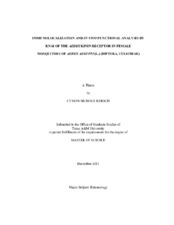| dc.description.abstract | The evolution of the blood feeding adaptation has required precise coordination of multiple physiological processes in the insect, such as reproduction, behavior, digestion and diuresis. These processes are under careful synchronous hormonal control. For rapid excretion, multiple diuretic hormones are known. Although originally described based on their ability to stimulate hindgut contractions, the Aedes kinins have been shown to stimulate fluid secretion in female mosquitoes of Aedes aegypti. Aedes kinins are leucokinin-like neuropeptides released from neurosecretory cells in the brain and abdominal ganglia. They act by binding to the Aedes kinin receptor, a G proteincoupled receptor (GPCR). The Aedes kinin receptor has been cloned, sequenced, functionally characterized, and immunolocalized to stellate cells in the Malpighian tubules of Ae. aegypti. In addition to their myotropic and diuretic roles, leucokinin-like peptides and/or their receptors have been also been discovered in the nervous, digestive, and reproductive systems of other arthropod species. Therefore, the Aedes kinins have the potential to function in several simultaneous physiological processes that are stimulated by blood feeding. This thesis aims to understand better their role in the whole mosquito by investigating the Aedes kinin receptor's global expression as well as its in vivo contribution to post-prandial diuresis.
Presence of the Aedes kinin receptor was investigated in the head, posterior midgut (stomach), hindgut, ovaries, and Malpighian tubules of both non blood-fed and blood-fed females by western blot using anti-receptor antibodies. The receptor was then immunolocalized in the posterior midgut and rectum. Finally, RNAi was employed to knock down kinin receptor expression, followed by measurement of in vivo urine excretion post blood feeding in a precision humidity chamber. Transcript and protein knockdown were confirmed by qPCR and immunohistochemistry, respectively.
Results indicate widespread expression of the Aedes kinin receptor protein in organs novel for hematophagous insects and demonstrate the receptor's fundamental role in rapid diuresis. These findings strongly point to the Aedes kinins as integrative signaling molecules that could coordinate multiple physiological systems. The Aedes kinins could therefore have contributed to the success of the blood feeding adapation in mosquitoes. | en |


